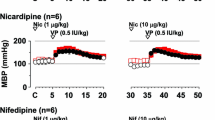Summary
Tilisolol is a beta-blocking agent with vasodilatory properties that was recently shown to possess a potassium (K+) channel opening activity. We investigated whether tilisolol has vasodilatory effects on coronary circulation in dogs. Mongrel dogs were chronically instrumented for measurements of circumflex coronary artery diameter (CoD) and coronary blood flow (CBF). We compared the effects of tilisolol on dog coronary arteries with those of two beta-blockers, propranolol and arotinolol. Both propranolol (1 mg/kg, intravenously, IV) and arotinolol (0.25 mg/kg, IV) decreased CoD and increased coronary vascular resistance (CVR). Tilisolol (2 mg/kg, IV) decreased CVR but had no significant effect on CoD. To investigate the mechanism of the coronary action of tilisolol, we examined differences in the response to tilisolol in the absence and presence of glibenclamide, an ATP-sensitive K+ channel blocker. Tilisolol (1,2,4 and 8 mg/kg, IV) produced a dose-dependent decrease in CVR without glibenclamide, whereas pretreatment with glibenclamide significantly suppressed this effect. Without glibenclamide, tilisolol had no significant effect on CoD at doses of 1–4 mg/kg (IV). However, at the higher dose of 8 mg/kg (IV), tilisolol significantly increased CoD (1.00±0.15%, p<0.01). After pretreatment with glibenclamide, tilisolol (1–8 mg/kg, IV) produced a significant decrease in CoD. Therefore, we concluded that tilisolol exerts its vasodilatory effect on the coronary circulation through an ATP-sensitive K+ channel opening mechanism, and that its vasodilatory action is more prominent in coronary resistance vessels than in large coronary arteries.
Similar content being viewed by others
References
Yasue H, Omote S, Takizawa A, Nagao M. Coronary arterial spasm in ischemic heart disease and its pathogenesis. A review. Circ Res 1983;52(Suppl I):147–152.
Yasue H, Omote S, Takizawa A, Nagao M, Miwa K, Tanaka S. Circadian variation of exercise capacity in patients with Prinzmetal's variant angina: Role of exercise-induced coronary arterial spasm. Circulation 1979;59:938–948.
Suzuki Y, Sugai T, Kobayashi A. A new potent beta-adrenergic blocking agent, N-696 (abstr). In: Eighth International Congress of Pharmacology, Tokyo 1981, P382.
Kubota N, Hagiwara K, Sugai T, Nagase M, Suzuki Y, Kobayashi A. Pharmacology of a β-adrenergic blocking drug, (±)-4-(3-tert butylamino-2-hydroxypropoxy)-2-methyl-l(2H)-isoquinolinone hydrochloride (N-696) (in Japanese). Clin Rep 1988;22:329–341.
Nakagawa Y, Sugai T, Chin W-P, Shibuya T, Hashimoto K, Imai S. Pharmacological profile of a new β-adrenoceptor blocker, 4-(3-(tert-butylamino)-2-hydroxypropoxy)-N-methylisocarbostyril hydrochloride (N-696). Arzneimittelforschung 1984;34:194–199.
Tsukiyama H, Otsuka K, Takasaki I, Horii M. Hemodynamic effects of dilevalol and N-696, new β-blocking agents with vasodilating properties, and doxazosin and urapidil, new α-blocking agents, in essential hypertension. J Cardiovasc Pharmacol 1988;11(Suppl 2):S32-S35.
Imaizumi T, Takeshita A, Nakamura N, et al. Vasodilating effect of the new β-blocker tilisolol hydrochloride in humans. Arzneimittelforschung 1988;38:1342–1344.
Sugai T, Kojima K, Iwakami N, Suzuki Y. Vasorelaxant and hypotensive effects of tilisolol hydrochloride (N-696) in isolated rat thoracic aorta and pithed rats. Jpn J Pharmacol 1991;57:367–375.
Takekoshi N, Murakami E, Matsui S, Murakami H, Emoto J, Hashimoto A. Studies on concurrent alpha- and beta-adrenoceptor blocking action of S-596 (arotinolol). Jpn Heart J 1983;24:925–933.
Richards DA, Tuckman J, Prichard BN. Assessment of α- and β-adrenoceptor-blocking actions of labetalol. Br J Clin Pharmacol 1976;3:849–855.
Schmid-Antomarchi H, De Weille J, Fosset M, Lazdunski M. The receptor for antidiabetic sulfonylureas controls the activity of the ATP-modulated K+ channel in insulin-secreting cells. J Biol Chem 1987;262:15840–15844.
Buckingham RE, Hamilton TC, Howlett DR, Mootoo S, Wilson C. Inhibition by glibenclamide of the vasorelaxant action of cromakalim in the rat. Br J Pharmacol 1989;97: 57–64.
Yoneyama F, Satoh K, Taira N. Nicorandil increases coronary blood flow predominantly by K-channel opening mechanism. Cardiovasc Drugs Ther 1990;4:1119–1126.
Imagawa J, Akima M, Nabata H, Taira N. Spasmolytic action of nicorandil in canine conductive coronary arteries in vivo is not modified by glibenclamide. J Cardiovasc Pharmacol 1992;19:108–114.
Yamada H, Yoneyama F, Satoh K, Taira N. Specific but differential antagonism by glibenclamide of the vasodepressor effects of cromakalim and nicorandil in spinallyanaesthetized dogs. Br J Pharmacol 1990;100:413–416.
Hashimoto K, Kinoshita M, Ohbayashi Y. Coronary effects of nicorandil in comparison with nitroglycerin in chronic conscious dogs. Cardiovasc Drugs Ther 1991;5:131–138.
Nakae I, Liu Q, Hashimoto K, Sugimoto Y, Tsutamoto T, Kinoshita M. Mechanism of the vasodilatory action of nicorandil on coronary circulation in dogs. Cardiovasc Drugs Ther 1994;8:137–145.
Goodman CA, Castellana FS. A digital sonomicrometer for two-point length and velocity measurements. Am J Physiol 1982;243:H634–639.
Nakae I, Liu Q, Sugimoto Y, Tsutamoto T, Kinoshita M. Glibenclamide-induced oscillation of canine coronary artery is independent of myocardial ischemia. J Cardiovasc Pharmacol 1994;23:473–479.
Vatner SF, Hintze TH, Macho P. Regulation of large coronary arteries by β-adrenergic mechanisms in the conscious dog. Circ Res 1982;51:56–66.
Drieu la Rochelle C, Roupie E, Hittinger L, et al. Dilatation of large coronary arteries induced by potassium channel openers in conscious dogs is abolished after coronary endothelium removal (abstract). Circulation 1991;84(Suppl II): II185.
Berdeaux A, Drieu La Rochelle C, Richard V, Giudicelli J-F. Differential effects of nitrovasodilators, K+-channel openers, and nicorandil on large and small coronary arteries in conscious dogs. J Cardiovasc Pharmacol 1992;20(Suppl 3):S17-S21.
Canty JMJr, Schwartz JS. Nitric oxide mediates flow-dependent epicardial coronary vasodilation to changes in pulse freuency but not mean flow in conscious dogs. Circulation 1994;89:375–384.
Chu A, Murray JJ, Lin CC, Russel M, Hagen PO, Cobb FR. Preferential proximal coronary dilatation by activators of guanylate cyclase in awake dogs. Am J Physiol 1990;259: H340-H345.
Nakae I, Takahashi M, Kinoshita T, Matsumoto T, Kinoshita M. The effects of S-nitrosocaptopril on canine coronary circulation. J Pharmacol Exp Ther, 1995;274:40–46.
Nagatomo T, Tsuchihashi H, Sasaki S, Nakagawa Y, Nakahara H, Imai S. Displacement by α-adrenergic agonists and antagonists of 3H-prazosin bound to the α-adrenoceptors of the dog aorta and the rat brain. Jpn J Pharmacol 1985;37: 181–187.
Author information
Authors and Affiliations
Rights and permissions
About this article
Cite this article
Liu, Q., Nakae, I., Takahashi, M. et al. Tilisolol hydrochloride dilates coronary arteries through an ATP-sensitive K+-channel opening mechanism in dogs. Cardiovasc Drug Ther 10, 23–30 (1996). https://doi.org/10.1007/BF00051127
Received:
Accepted:
Issue Date:
DOI: https://doi.org/10.1007/BF00051127




